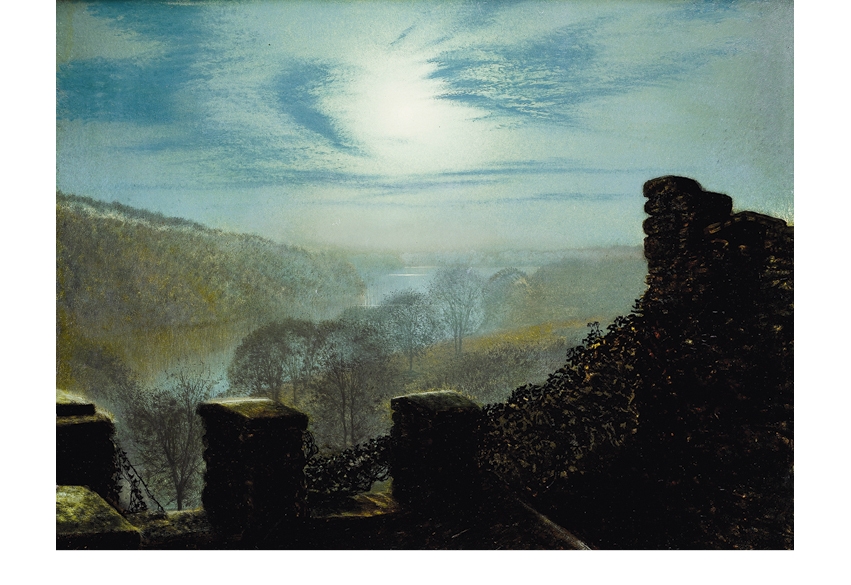At the less than enticing Guildhall Art Gallery, a purpose-built museum that manages immediately to depress the spirits by its utterly unsympathetic design, is a major exhibition of John Atkinson Grimshaw (1836–93), the celebrated Victorian painter of moonlight. The show is the brainchild of Jane Sellars, director of the Mercer Art Gallery, Harrogate, where it was on view before coming to London. I wish I’d had the time and energy to see it in Harrogate, where I’m sure it looked entirely at home in the very particular spaces of the Mercer. Exhibiting in the Guildhall is an uphill battle with the architecture. Even Grimshaw, chock-full of atmosphere and drama, has a hard time of it here.
At the age of 24, Grimshaw struck out on his own to be a painter, leaving his secure job as a clerk with the Great Northern Railway in Leeds, despite parental disapproval. He was very much a self-made man, that Victorian model, and taught himself how to paint by following the examples available to him. He was particularly influenced by another Leeds painter, John William Inchbold, an adherent of the new Pre-Raphaelite mode of painting. Actually, Grimshaw’s Pre-Raphaelite pictures are not at all bad, and though I don’t much go for imitations of Birds’ Nest Hunt, Grimshaw’s meticulously detailed early landscapes are not without appeal. Reproduction does not give the extraordinary, even hallucinogenic, technicolour quality of ‘Nab Scar, the Lake District’ (1864), with its foreground saturated hues.
Within a few years, he was discovering his own subjects, as can be seen in ‘On the Tees, near Barnard Castle’, a watercolour nocturne from c.1868, with a wonderful stippled sky and subtle modulations of colour across the centre. From 1869 comes a tour-de-force of woodland observation, ‘Autumn Glory: The Old Mill’, a painting with at least two of Grimshaw’s mature characteristics — the intricate tracery of boughs as seen against buildings (or sky), and the golden season of autumn. How appropriate for this exhibition to be showing now, as the ‘season of mists and mellow fruitfulness’ takes over the land. And what a tribute Grimshaw pays to his favourite time of year — to be matched only by his evident devotion to the equivalent time of day: twilight.
Whistler famously said, ‘I thought I had invented the nocturne until I discovered Grimmy’s moonlights,’ high praise indeed from the master of the subfusc and vespertine. Grimshaw presented an acceptable face of industrial England, not by painting its smoke-blackened factories, but by showing the fruits of the country’s wealth in the more picturesque terms of moonlit harbour scenes or busy commercial thoroughfares on a twinkly, festive evening. Of course, it’s a heavily romanticised vision, but not without its own distinctive brumous charm.
At the Guildhall Gallery, walk through to the Copley Room for a full appreciation of Grimshaw’s genius. Although his paintings are hung on screens below the gigantic canvas of ‘The Defeat of the Floating Batteries at Gibraltar, September 1782’ by John Singleton Copley, and cannot help but be slightly overawed by this permanent feature of the gallery (which looms over every exhibition), there are some beautiful paintings here. Chief among them are ‘Silver Moonlight’ (1886), ‘November Morning’ (1883), ‘Nightfall on the Thames’ (1880) and the series devoted to Whitby. I was particularly captivated by two untypical late tonal works — ‘Sand, Sea, Sky: A Summer Fantasy’ and ‘Snow and Mist: Caprice in Yellow Minor’, which suggest how he might have developed had he lived longer.
There is a substantial catalogue accompanying the show (£20, paperback), full of learned essays and more than 150 illustrations. An artist’s biography, however touching (Grimshaw and his wife had 15 children, of which only five survived), is no compensation for bad painting, though it might help to explain it. Luckily with Grimshaw, this is not the case, and although he tended to repeat himself, and some paintings are inevitably better than others, he managed to maintain a reasonably high standard of production. But for all the variety of subject in this exhibition (such as the Tissot-esque depictions of women), the paintings for which he is best known are in fact his high point of achievement, and are the images that will linger in the mind. For those who are interested, there is also a display off the foyer of photographs inspired by Grimshaw by the Bradford-based photographer Liza Dracup. These were commissioned by the Mercer but did not manage to hold my attention, I’m sorry to say. Grimshaw is a hard act to follow.
What better way of following him than by another exhibition, this time part loan and part for sale, of the man himself? At Richard Green’s commodious premises in Bond Street, Grimmy’s moonlights are offered in sympathetic surroundings, particularly in the large, top-lit rear gallery. Green has been dealing in Grimshaw for more than 20 years, so has helped to build up both expertise and client-base for the artist, and is one of the sponsors of the Harrogate/London show. The paintings can be closely examined here and reveal different pleasures from near-scrutiny than they do viewed from a distance. The loose, almost calligraphic treatment of tree limbs, the speckling and dry brushing are all as worthy of note as the drifts of maroon and gold leaves and the blue reflections on moonlit puddles. Mr Green has gathered together a highly enjoyable selection of Grimshaws, large and small, opulent and intimate, urban and rural.
Atkinson Grimshaw, having done very well for himself in his lifetime, died at the age of 57 in straitened financial circumstances. His work went out of fashion, but came back in the 1970s, when I first started to look at it and was at once beguiled and enthralled. I was young then, and the delicious melancholy that pervades so much of his work was nectar to the adolescent soul. If neither this mysterious silvery loneliness nor the golden twilight of nostalgia has quite the same power to entrap and hold me these days, I think none the less of his considerable achievement. There’s no one quite like Grimshaw, as these two exhibitions ably demonstrate.






Comments